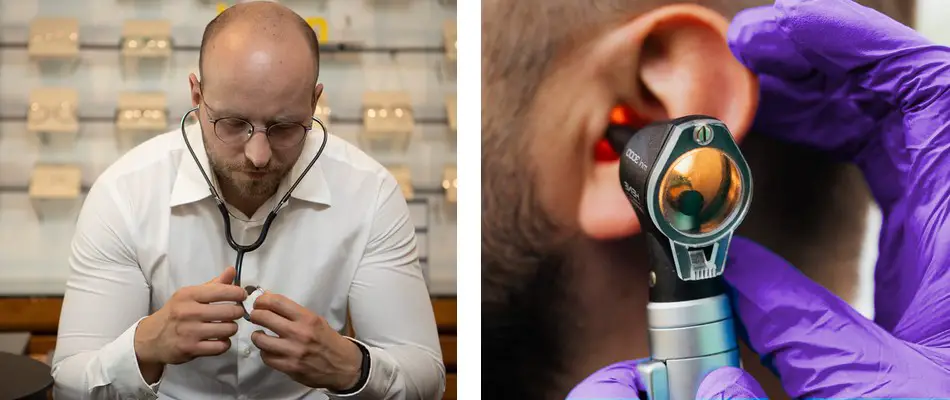The hearing care professional obtains an overall picture of the patient’s hearing during the first appointment. A number of data are collected for this purpose. For example:
- Problematic situations in which hearing can be improved.
- Previous experience with hearing aids
- Use of medication
- Known medical conditions affecting the ears
- General diseases that can affect hearing: e.g. diabetes
- Otoscopy (examination of the auditory canal)
- Tympanometry (the acoustic resistance of the middle ear is examined.)
- Audiometry (from when sounds are perceived/hearing level)
- How well can you understand speech (in quiet and in a noisy environment)
- Condition of the ear tissue (Is it harder or softer)
- Size and form of the ear canals
- and much more…
Once this information has been gathered, your hearing care professional can make a recommendation for specific hearing aids right within the first appointment. Of course, he will take your wishes into account if you would like to have a particularly small design or if certain features such as Bluetooth compatibility are important to you.
In many cases, you can also expect the first hearing aid to be fitted directly and get a first hearing impression. You will then experience what it means when your hearing loss has been compensated. The hearing care professional needs another 15-20 minutes for the fine-tuning after the selection of the hearing aid.
Most of the time you can take the hearing aids home for testing. All this is free of charge and without obligation.
Although technology is always advancing, you should be aware that hearing aids often cannot compensate for complete hearing loss. Partly this is due to the limitations of the hearing aid but partly also due to a weaning of the perception of sounds. So if you are hearing sounds again for the first time, this may still mean that some kind of training period will be needed until you get used to the hearing aids.

What Does an Audiologist Look For?
The hearing care professional will test and evaluate your hearing. Here, abnormalities are noticed that may only be temporary and do not require a hearing aid adjustment but therapy. And there are hearing losses for which a certain type of hearing aid or implant would work better than others.
For this reason, a complete check-up of your hearing involves a somewhat longer appointment of about 90 minutes.
The best care only makes a difference if it can also be accepted in everyday life. For this reason, professional hearing care professionals also plan enough time for your questions. In this way, you can go through the options that come into question for you with the specialist in an easy-to-understand manner and make the optimal choice.
For example while some people need a closed ear mold while other patients should not be fitted with a closed ear mold. This is something only the audiologist can decide after he or she looked at every detail and spoke to you about your problems and experiences.
How Long Does an Audiology Appointment Take?
Plan about 1.5 hours for an initial appointment with the hearing care professional. During this appointment, they will take time with you to measure your hearing in detail and advise you on the options available on the market. Follow-up appointments with the hearing care professional usually range from 20 minutes to an hour.
If there is only a small adjustment to be made during the appointment and the hearing aid is subjected to a brief check-up, 20 minutes is quite sufficient. However, if the fitting needs to be restarted or individual changes to your earmold need to be highlighted, then you should plan for closer to 30 to 60 minutes.
How Long Does It Take To Fit a Hearing Aid?
The total period of a hearing aid fitting usually extends over two to four weeks, as different hearing aids are tried out. The hearing aid user then usually comes to the hearing care professional once a week to test a new variant within the fitting or to have the device readjusted.
Hearing aids can have a significant impact on your quality of life, but it doesn’t happen overnight. It can take up to six months for you to get used to the sounds you have regained.
The longer the hearing loss, the more difficult and lengthy the process of fitting hearing aids can be.
Multiple appointments for hearing aid fitting should be considered in any case. The reason for this is that at the hearing care professional’s office, you do not yet know how situations will sound to you in everyday life.
In some cases, you may hear too much rustling, background noise may be too noticeable, or it may be too loud in general. However, such wishes could also only occur in a specific situation in which you could then receive another program from your hearing care professional.
Test the devices during the fitting process for at least several days to gain experience. Go to the cinema, theater and seek the company of friends. In such situations you will then realize which wishes or improvement possibilities you see and have.
Why Does Early Fitting of Hearing Aids Make Sense?
Early fitting of a hearing aid is highly recommended because hearing aids can slow down or even stop the loss of hearing.
This is because a hearing aid ensures that sound impulses continue to reach the auditory cells and are perceived. This means that they do not “unlearn” to hear the sounds.
Wearing hearing aids therefore also actively helps to prevent further difficulties and to preserve hearing ability.
